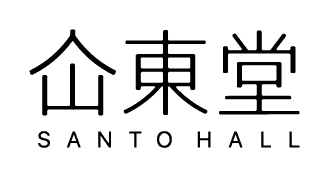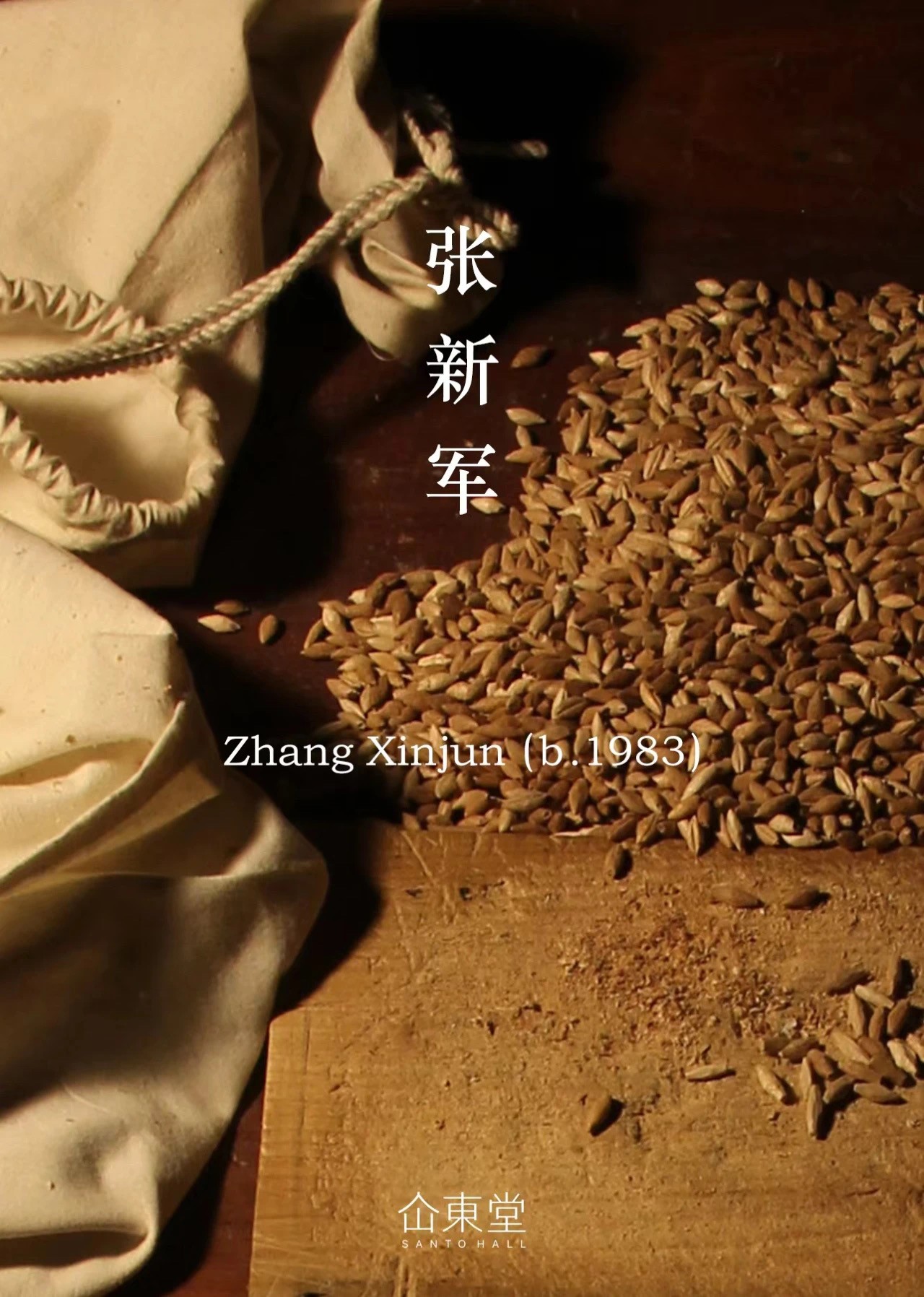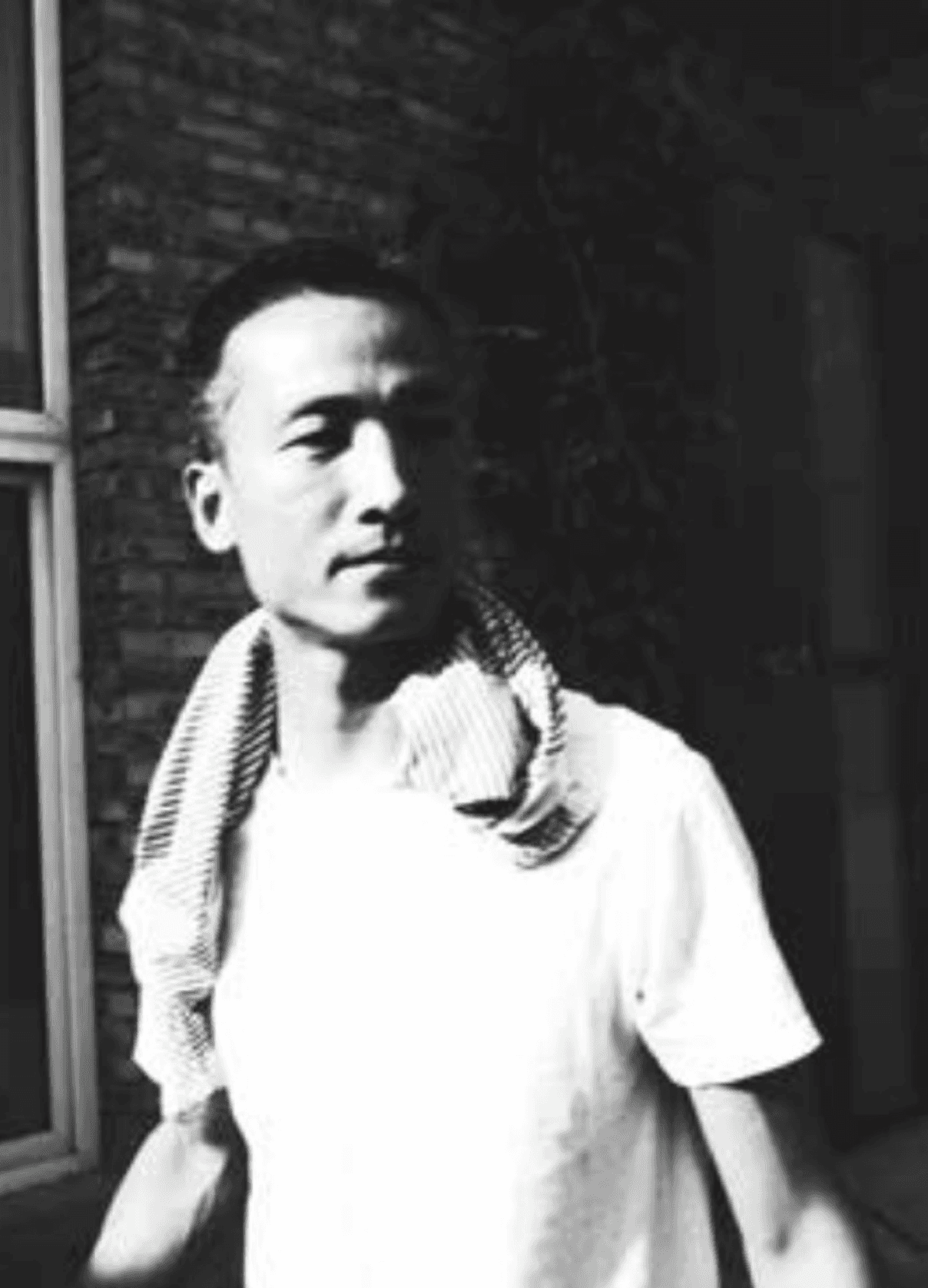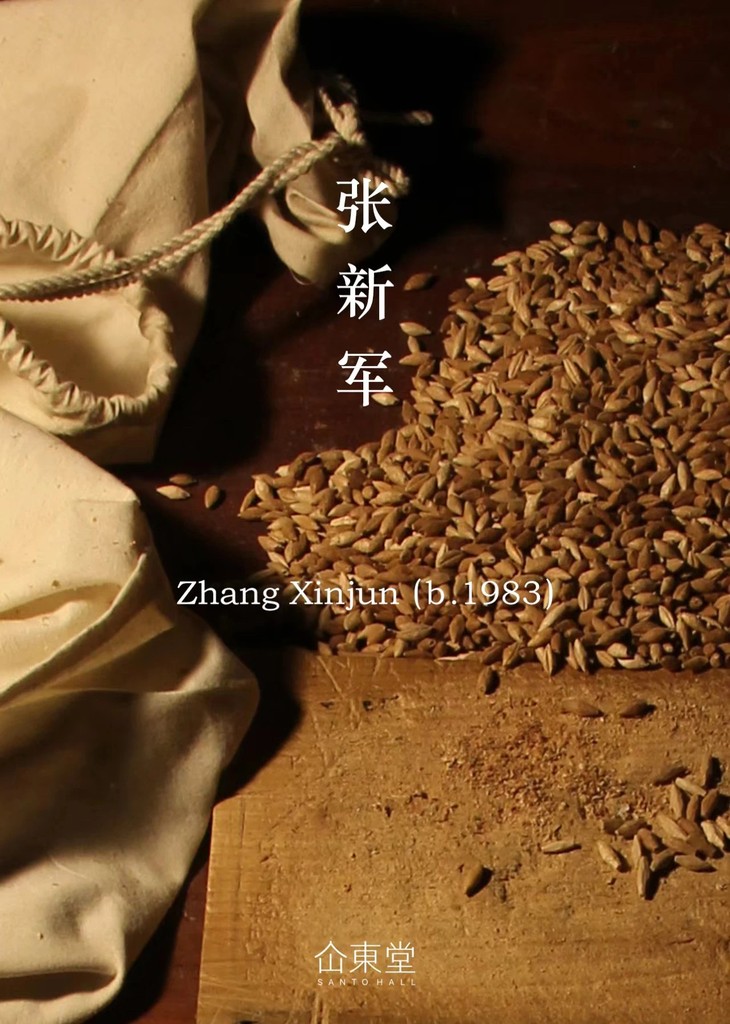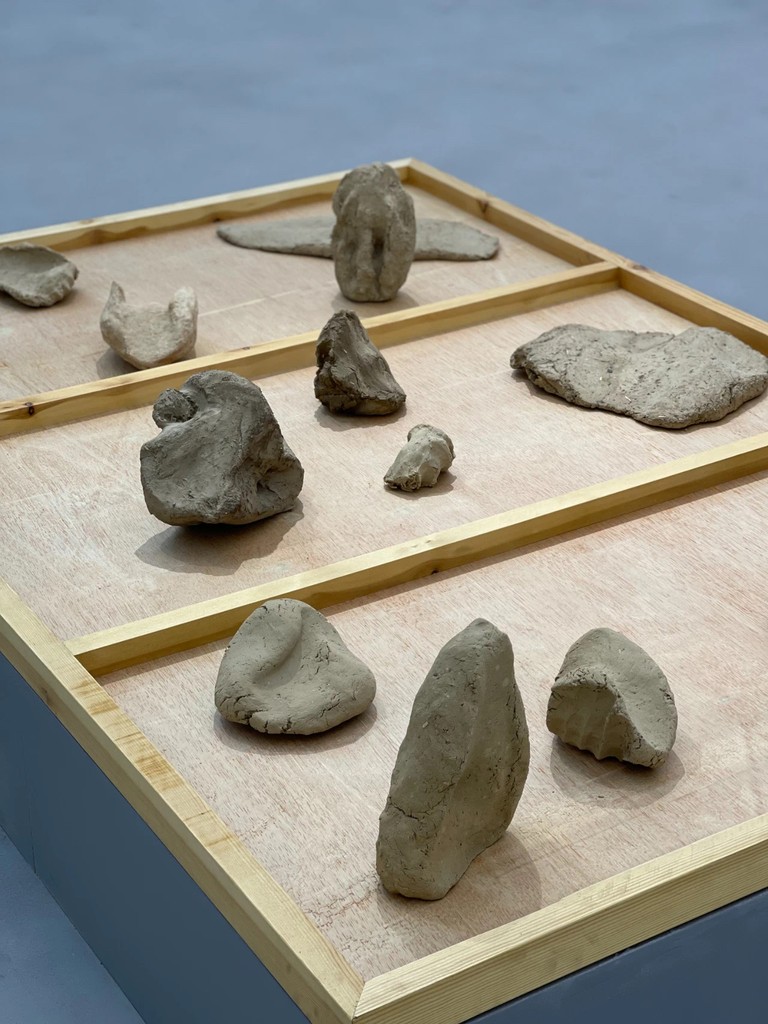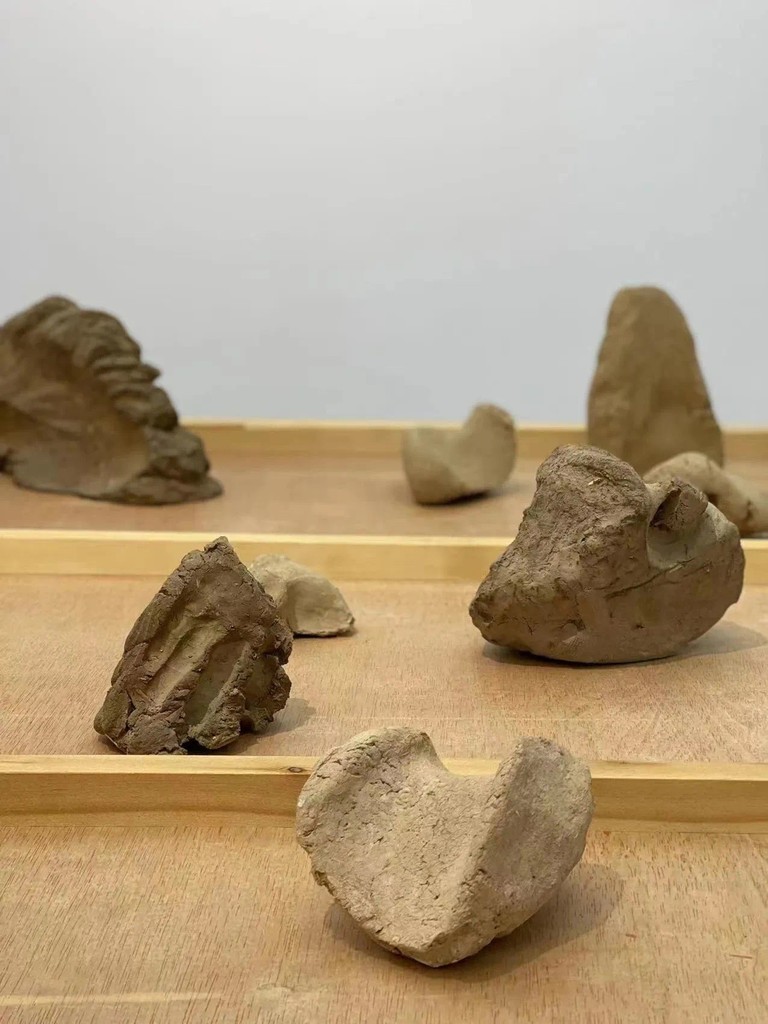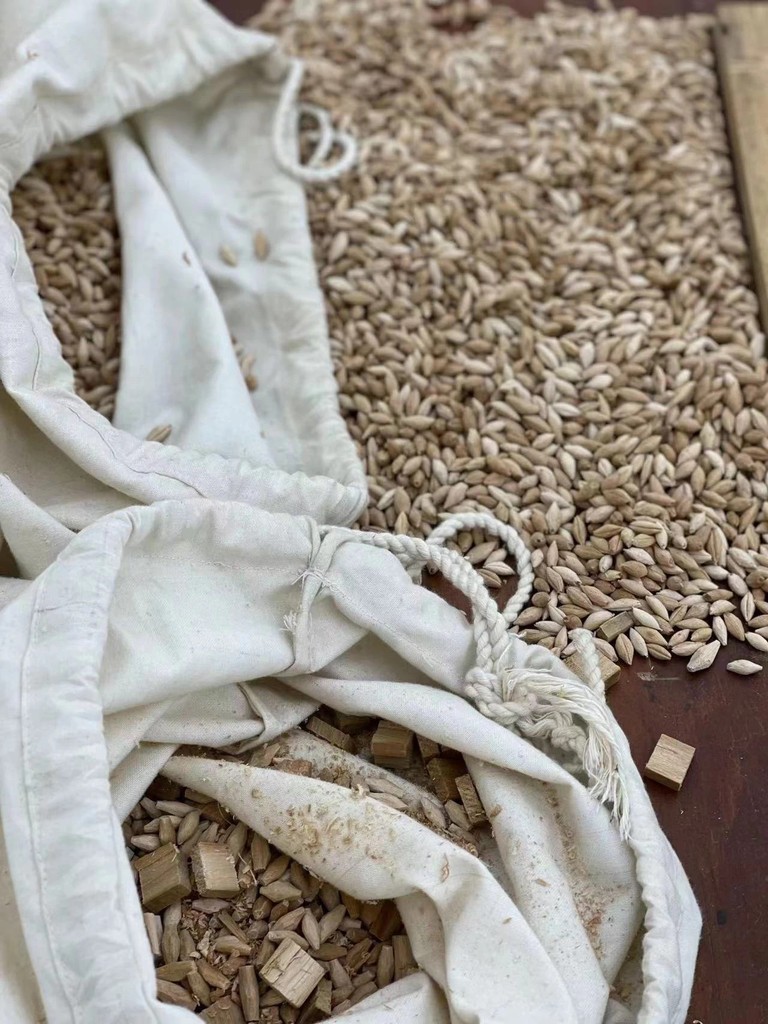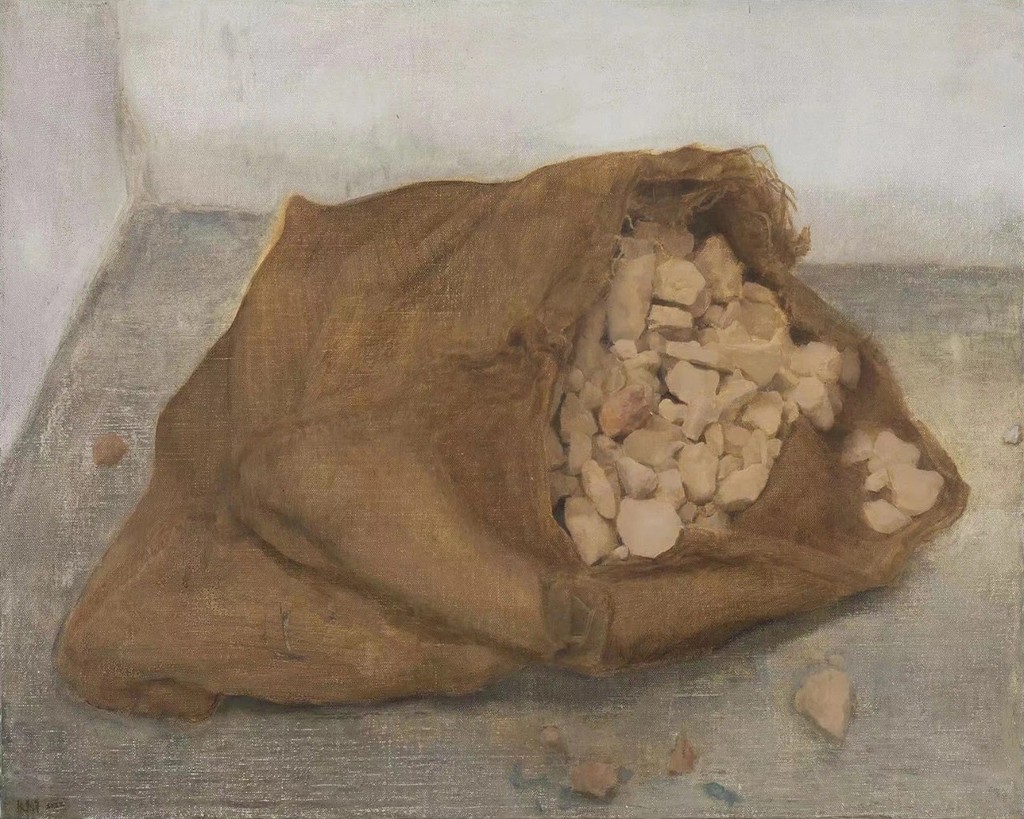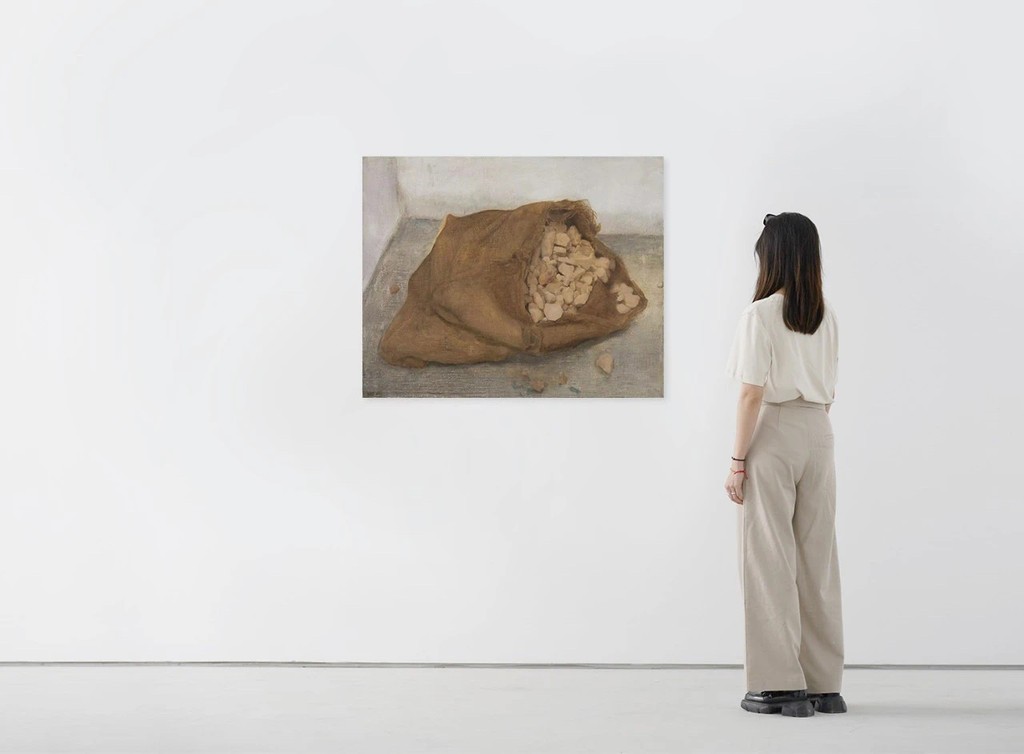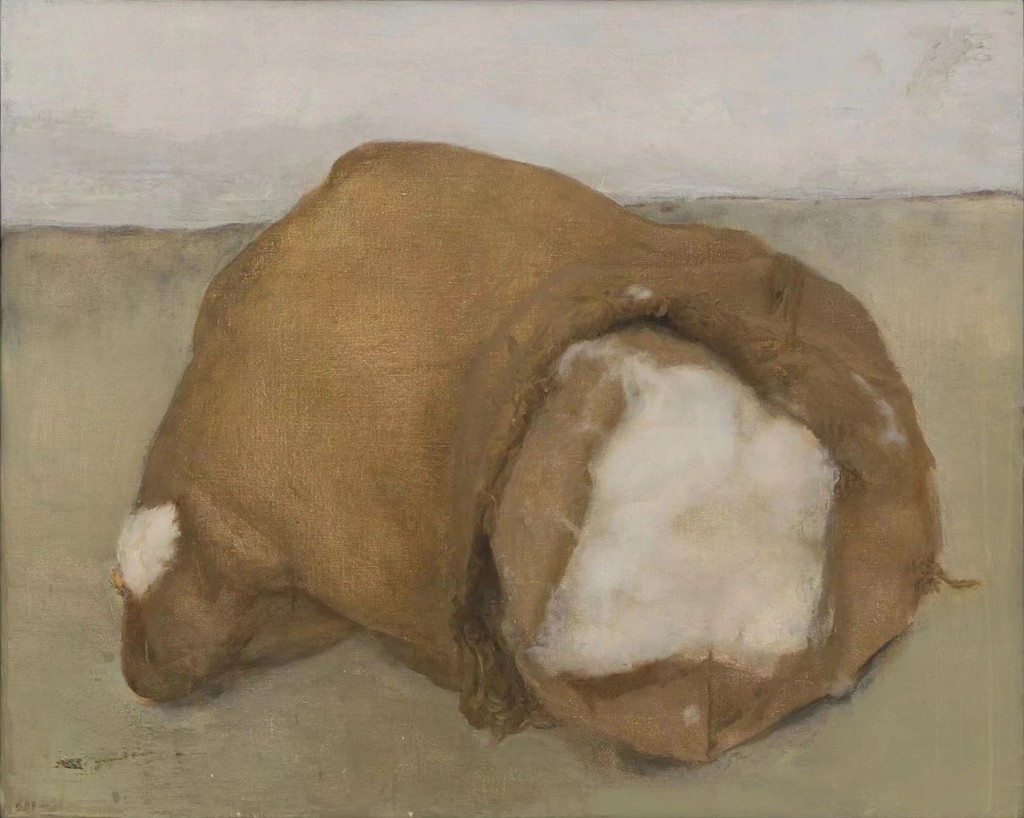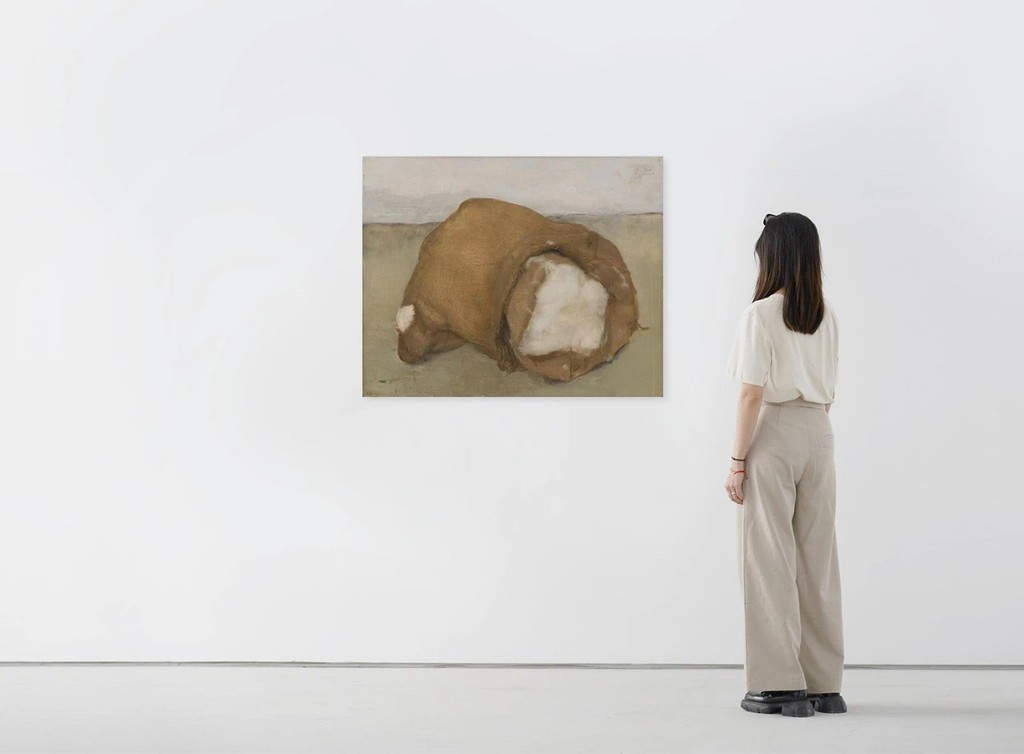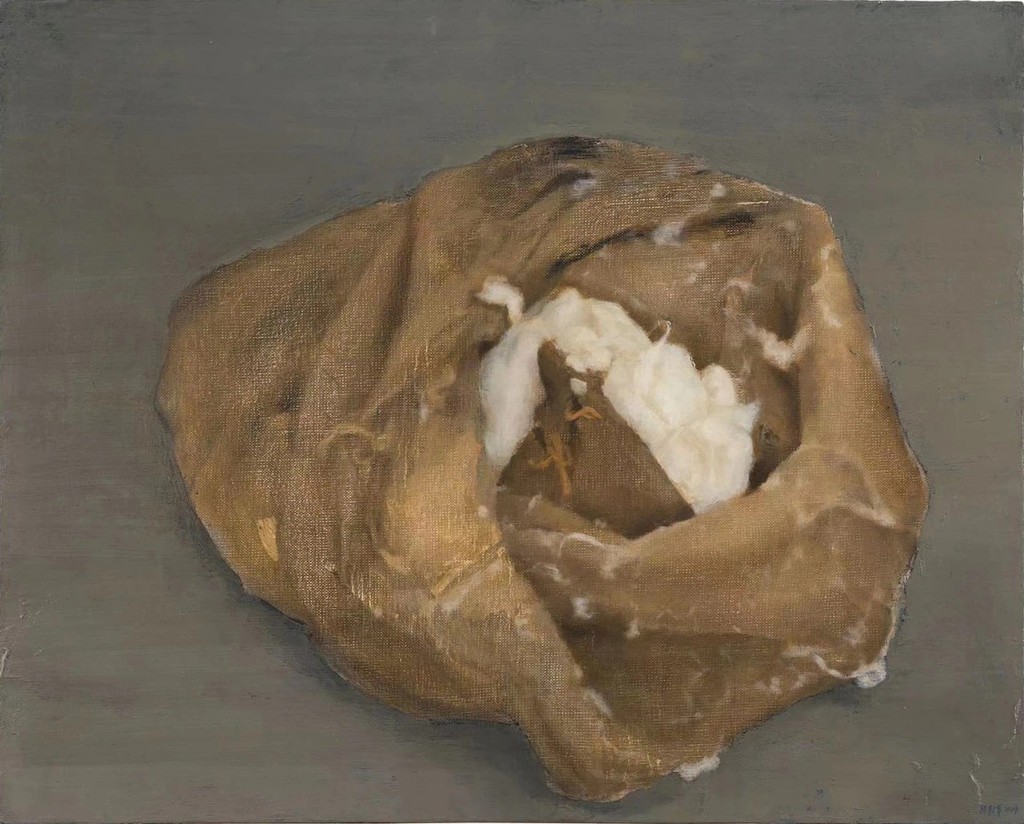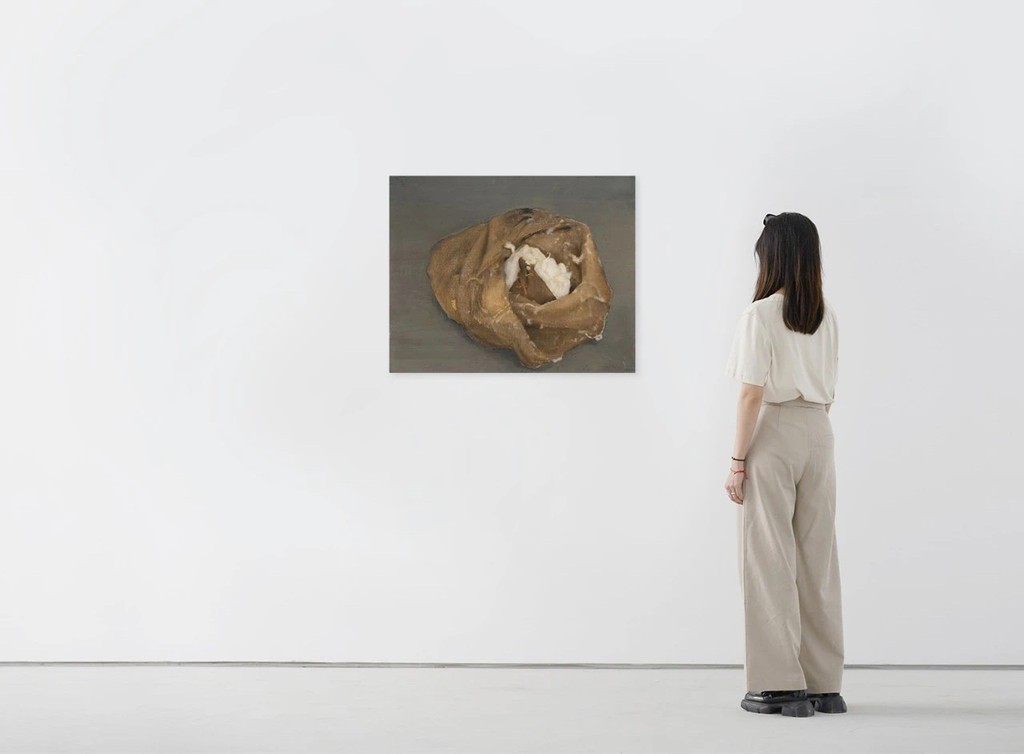身体是通往现实的路
The Body is the Path to Reality
文/冯子杰
艺术家张新军的作品具有明显的叙事性,比起分析性地将他的作品分解为各样要素,我们更需要找到其作品叙事的内在脉络,从而领会写实之物背后的复杂意象。张新军为我们提供的解读的钥匙,就是身体的感受、领会、在场,并以此为中介向我们呈现他对现实世界的理解。
《矿》,土、麦秸、木板,180×120 cm,2017
《矿》,局部
张新军擅长将身体与大地的要素关联起来,如作品《矿》、《麦》等。在《矿》中,张新军以身体肢节的动作为泥土塑形,作品一方面作为身体的负空间的印记,另一方面作为当下空间的现实性存在,表达了现实与身体的辩证法:身体生活在现实的大地上并留下痕迹,而现实恰恰又是通过身体的活动得到呈现。就此而言,《矿》要展示的并非是由土与麦秸以及木板组合而成的对象物,而是现实与身体共同寓于其中的空间。
这种对“身体”的自觉,构成了张新军作品的核心语言,并在作品中浓缩了几乎整个从近代到现代的哲学流变——世界是作为主体的自我的世界,而自我应当是具身的存在,世界通过我们的肉身体验得到造型和转化。
《麦》,局部
《麦》,木,帆布,尺寸可变,2020-2021
例如《麦》,张新军将自己曾经用过的床板处理为麦粒的形态。床板与麦本来并无任何概念上的关联,在《麦》中却通过身体的劳作打破物与物之间的界限并使之融合。床板与身体之间有一种原生的交互关系,如今通过艺术的发生转化为一颗颗麦粒,身体与现实的交互便得到了造型的表达;而这一从2017年开始并将继续下去的物的转化,表现了世界流变的生生不息与肉身体验的多元变化,以免艺术表达囿于物的枷锁之中。
如果说作为装置的作品呈现了身体在表象现实世界时的中介性,张新军的绘画作品则是呈现了身体的主体性。在作品《棉白》、《盛开》和《难民》中,张新军以象征的手法将画作中的麻袋表达为人与现实交互的界限概念,画面中写实的表达通过肉身体验抽象为各样的意象。对张新军来说,并非无端的想象,或者故弄玄虚的文字游戏将物关联起来,而恰恰是他的肉身体验作为主体决定了意象的意义。破洞的麻袋被想象成破烂衣衫抑或是断壁残垣,都是将他自己对温度的体验以及与外界交互的一种表达。
《难民》,布面油画,80x100cm,2022
《难民》,场景
在《难民》中,身体的要素如何让观者将土块的组合关联到人的意象?也许是赤脚走在泥土上的触感残留,也许是手捏泥巴的童年稚趣,也许是人们留下过汗水的一片麦田,也许是入土为安的安息。诸多可能的体验,让土块超越物而化身为人。这种由身体主导的叙事摆脱了符号学意义上僵化的指称或例示关系,从而主张对世界的解释会因为与身体的关联而具有无限的可能性。
《棉白》,布面油画,80x100cm,2022
《棉白》,场景
最后,正如海德格尔所说,人作为此在就是在世界之中存在,过程中有时难免非本真地活着;艺术是我们回归本真的一条路,而这正是张新军的艺术的动人之处。他的作品总是通过身体与大地、矿物、粮食、温度关联起来,这种朴素而深沉的表达与被炫目的商品与技术麻痹感官的当下——通过符号把人从大地抽离出来并成为符号的奴隶——形成鲜明的对比,这使得作品有种返璞归真的审美气质。
《盛开》,布面油画,65x81cm,2022
《盛开》,场景
身体是通往现实的路,张新军不仅以其肉身体验来刻画他对现实世界的感知,更是将这一道路延伸到更远的艺术乌托邦。现实也许如泥土、麻布般平凡,这种表面的平凡初看起来也许不如绚丽的霓虹灯吸引眼球,从而被时代的喧嚣和浮躁暂时掩盖,但沉淀下来的厚重与丰富终究会在艺术中升华,让人得以诗意地栖居在大地之上。
The works of artist Zhang Xinjun are clearly narrative in nature. Rather than analytically breaking down his work into its various elements, we need to find the inner clue of his narrative in order to understand the complex imagery behind the realistic objects. The key to interpretation that Zhang Xinjun offers us is the feeling, comprehension and presence of the living body, which mediates his understanding of the real world to us. In this respect, what is presented in Mine is not an object made of earth and straw and wooden boards, but a space in which reality and the body coexist.
Zhang Xinjun specialises in associating the body with the elements of the earth, as in his works Mine and Wheat. In Mine, Zhang Xinjun uses the movements of his limbs to shape the clay, and the work serves as a mark of the body's negative space on the one hand, and the reality of the present space on the other, expressing the dialectic between reality and the body: the body lives on the earth and leaves its traces, while reality is presented precisely through the body's activities.
This self-consciousness of the body forms the core language of Zhang Xinjun's works, and distills in them almost the entire philosophical flow from modern to contemporary times - the world is the world of the self as a subject, and the self should be an embodied existence, and the world is modeled and transformed through our somatic experience.
In Wheat, for example, Zhang Xinjun transforms a bedpan he once used into the form of wheat. There is no conceptual connection between the bedpan and the wheat, but in Wheat, the boundaries between objects are broken and fused through the work of the body. There is an original interaction between the bedpan and the body, which is now transformed into grains of wheat through the artistic process, and the interaction between the body and reality is formatively expressed; this transformation of the object, which began in 2017 and will continue, expresses the ever-changing nature of the world and the multiplicity of physical experiences, so that artistic expression is not confined to the shackles of the object.
If the works as installations present the mediated nature of the body in representing the real world, Zhang Xinjun's paintings present the subjectivity of the body. In the works Cotton White, Blooming and Refugee, Zhang Xinjun uses symbolism to express the sacks in his paintings as a notion of the boundaries of human interaction with reality, the realistic expression in the images abstracted into various imagery through somatic experience. For Zhang Xinjun, it is not unwarranted imagination, or a mysterious play on words that connects the objects, but rather it is his somatic experience as the subject that determines the meaning of the imagery. The torn sack is imagined as a tattered garment or a broken building, both as an expression of his own experience of temperature and interaction with the outside world.
In Refugee, how does the somatic element allow the viewer to associate the soil blocks with imagery of human? Perhaps it is the tactile residue of walking barefoot on the earth, perhaps it is the childhood joy of squeezing mud with one's hands, perhaps it is a field of wheat where people have left their sweat, perhaps it is the resting place of a departed life. The many possible experiences allow the soil block to transcend the object and become a person. This body-led narrative moves away from the semiotic sense of rigid referential or exemplary relations, thus asserting that the interpretation of the world will have infinite possibilities because of its association with the body.
Finally, as Heidegger said, human as Dasein is to exist in the world, and in this process sometimes inevitably lives an unauthentic life. Art is a path to return to our true nature, and this is what makes Zhang Xinjun's artwork so moving. His works are always associated with the earth, minerals, food and temperature through the body, the simple and profound expression in his work that contrasts with the present time when the senses are paralyzed by dazzling commodities and technology - where people are taken out of the earth and become slaves to symbols through symbols. This is a stark contrast that gives his works an aesthetic quality of regressing to the true.
The Leib (living body) is the path to reality, and Zhang Xinjun not only uses his somatic experience to portray his perception of the real world, but also extends this path to a farther artistic utopia. Reality may be as mundane as mud and linen, and this superficial ordinariness may not as eye-catching as the gorgeous neon lights at first glance, and thus temporarily overshadowed by the hustle and bustle of the times, but the thickness and richness of reality that have settled down will eventually be sublimated in art, allowing people to dwell poetically on the earth.
